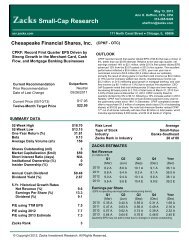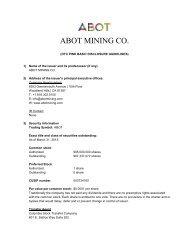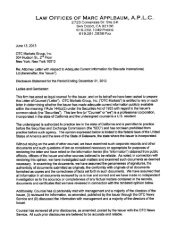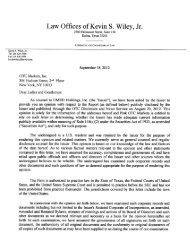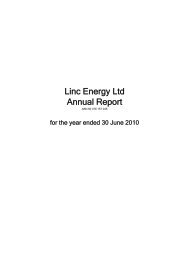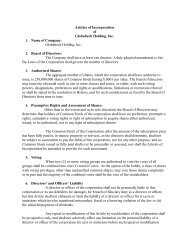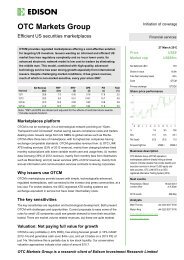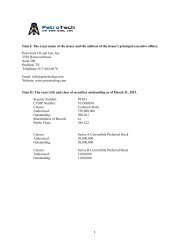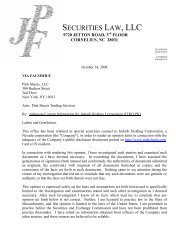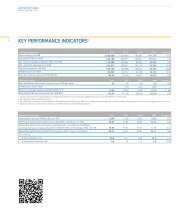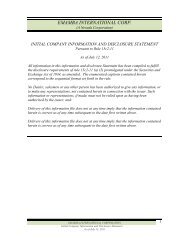2011 Annual Report - OTCIQ.com
2011 Annual Report - OTCIQ.com
2011 Annual Report - OTCIQ.com
Create successful ePaper yourself
Turn your PDF publications into a flip-book with our unique Google optimized e-Paper software.
Due to lower <strong>com</strong>modity prices and underutilized capacity,<br />
the OECD expects the inflation rate to decline during the<br />
forecast period.<br />
The OECD emphasizes the upside and the downside risks of<br />
its projections. The euro-zone debt crisis and U.S. fiscal policy<br />
are the main sources of uncertainty.<br />
Energy Markets<br />
We expect power and fuel markets to be generally more<br />
volatile in 2012 and 2013 due to their increasing sensitivity to<br />
macroeconomic developments and policy decisions.<br />
The oil market is currently displaying a classic backwardation<br />
pattern, with prices for nearby months higher than prices for<br />
forward months. This trend could continue, since at the moment<br />
the market is increasingly driven by geopolitical events (Iran’s<br />
nuclear program, EU sanctions, the Strait of Hormuz, unrest in<br />
the Middle East and North Africa). The Brent contract for nextmonth<br />
delivery started 2012 at about $112 per barrel, which is<br />
significantly above the price at the start of <strong>2011</strong> ($95).<br />
In <strong>2011</strong>, abundant coal stocks and lower demand due to mild<br />
winter weather were the fundamental factors on Europe’s<br />
coal market as measured by the API#2 index. The price for hard<br />
coal for next-year delivery began 2012 at $116 per metric ton,<br />
the same level as at the start of <strong>2011</strong>. Good availability and<br />
favorable freight rates could send prices lower. The main source<br />
of demand is the Asia-Pacific region, particularly China. Unlike<br />
oil, however, coal displays a contango pattern, with outlying<br />
periods priced higher than nearby periods. Consequently, the<br />
price for delivery in 2014 is currently $121 per metric ton.<br />
In <strong>2011</strong>, wholesale gas prices at Europe’s hubs, both for spot<br />
products and for forward products for delivery in 2012 and<br />
2013, were significantly higher than in the prior year. This is<br />
especially attributable to higher LNG demand in Asian markets,<br />
which was driven by economic growth in non-OECD countries<br />
and the replacement of nuclear capacity by gas-fired<br />
capacity in Japan following Fukushima. Higher oil prices, resulting<br />
in part from political developments in the Middle East<br />
and North Africa, are pushing up the prices of oil-indexed gas<br />
imports to Europe. The forward market shows rising gas prices<br />
in Europe for the next two years. To a significant degree, these<br />
CEO Letter<br />
E.ON Stock<br />
Combined Group Management <strong>Report</strong><br />
Consolidated Financial Statements<br />
Corporate Governance <strong>Report</strong><br />
Supervisory Board and Board of Management<br />
Tables and Explanations<br />
expectations continue to be driven by LNG demand in Asia<br />
and have so far not been shaken by concerns about a collapse<br />
of demand in Europe due to a renewed danger of recession.<br />
U.S. gas prices are expected to remain at low levels due to<br />
the cost-effective extraction of shale gas, despite the apparent<br />
environmental risks of this practice.<br />
Prices for carbon allowances under the EU Emissions Trading<br />
Scheme (known as “EUAs”) fell to record lows in <strong>2011</strong>, primarily<br />
because the weak economy led to lower industrial production<br />
and consequently to lower demand for power, resulting in an<br />
ongoing oversupply of EUAs. In the years ahead, this trend<br />
could be augmented by emission-reduction measures (such as<br />
measures to increase energy efficiency), which would put<br />
further downward pressure on EUA prices. Low EUA prices have<br />
led EU policymakers to consider taking steps (such as a setaside<br />
strategy) to reduce the number of EUAs on the market.<br />
In view of Europe’s lackluster economic situation, however,<br />
such a proposal would probably meet stiff resistance from a<br />
number of member states. More negative news about the<br />
euro zone and the absence of progress in policies to reduce<br />
the number of EUAs could mean that carbon prices reach<br />
new lows in the years ahead.<br />
Near-term and medium-term power prices in Germany will<br />
be determined largely by the price of hard coal, natural gas, and<br />
EUAs and by forecasts on the ratio of supply to demand in<br />
Germany and neighboring countries. However, new capacity,<br />
particularly new renewables capacity, could put further downward<br />
pressure on prices (at the start of 2012, Germany had<br />
24.7 GW of installed solar capacity and 30 GW of installed<br />
wind capacity). This pressure could be increased in the years<br />
ahead by concerns about Europe’s economic outlook and<br />
the con<strong>com</strong>itant lowering of growth expectations for power<br />
consumption. Still, the market’s general expectation is for<br />
forward power prices to remain at roughly the same level over<br />
the next two years due to continued low carbon prices and<br />
moderate coal and gas prices. At the start of 2012, the EEX baseload<br />
contract was trading at about €52 per MWh for 2013<br />
delivery and at €53 for 2014 delivery, similar to the level at the<br />
start of last year.<br />
61



